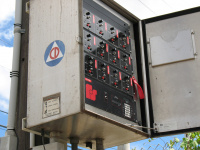MC: Difference between revisions
No edit summary |
(Added content on operation of controller.) |
||
| Line 1: | Line 1: | ||
{{Infobox siren | {{Infobox siren | ||
|image= [[File:MC6024.jpg|200px]] | |image= [[File:MC6024.jpg|200px]] | ||
|caption= An | |caption= An MC6024 in Hawaii. | ||
|type= Electronic Siren Controller | |type= Electronic Siren Controller | ||
|produced= 1989?-1995? | |produced= 1989?-1995? | ||
| Line 8: | Line 8: | ||
}} | }} | ||
The '''MC''' | The '''MC''', or '''M'''odulator '''C'''ontroller, was an electronic siren controller produced by Federal Signal Corporation for the [[Modulator]], [[DSA]], and [[EOWS]] series of sirens. | ||
==Operation== | |||
The MC was a new design of controller by Federal Signal, with the only similarities between it and its predecessor, the SiraTone, being the amplifiers used and the capability to run the [[EOWS]] 612 rotating speaker array. The controller was a microprocessor operated platform which used digital, solid state systems to produce the 7 signals provided by Federal Signal. Unlike the SiraTone, the MC had tones pre-loaded onto an audio ROM chip so there was no need for an analogue tone generator and timer circuit. Audio from the ROM chip was programmed by Federal Signal. The auxiliary tone was Westminster Chimes by default unless a different tone was requested for by the customer. | |||
The system was activated by two-tone or by DTMF by the controller's internal radio, locally by keying in a two digit code on the controller's keypad, or by operating the controller via landline. When using two-tone or DTMF, the siren has to be "armed" in order to operate. To do this a DTMF sequence would first be broadcast, then a signal DTMF string would be broadcast. Arm period would last for 5 minutes until automatic disarm, unless a "disarm" DTMF string was broadcast before the time expired. This is different, and more secure, to the SiraTone which required a jumper to be added in order to permanently arm the controller. After a signal was activated the digital audio was sent through a digital/analogue converter to each amplifier and onto the speaker array. | |||
[[Category:Electronic Siren Controls]][[Category:Federal Signal Corporation]][[Category:Siren Control Equipment]] | [[Category:Electronic Siren Controls]][[Category:Federal Signal Corporation]][[Category:Siren Control Equipment]] | ||
Revision as of 12:09, 6 July 2018
| MC | |
 An MC6024 in Hawaii. | |
| Produced | 1989?-1995? |
|---|---|
| Type | Electronic Siren Controller |
| Preceded by | SiraTone |
| Succeeded by | MCP |
The MC, or Modulator Controller, was an electronic siren controller produced by Federal Signal Corporation for the Modulator, DSA, and EOWS series of sirens.
Operation
The MC was a new design of controller by Federal Signal, with the only similarities between it and its predecessor, the SiraTone, being the amplifiers used and the capability to run the EOWS 612 rotating speaker array. The controller was a microprocessor operated platform which used digital, solid state systems to produce the 7 signals provided by Federal Signal. Unlike the SiraTone, the MC had tones pre-loaded onto an audio ROM chip so there was no need for an analogue tone generator and timer circuit. Audio from the ROM chip was programmed by Federal Signal. The auxiliary tone was Westminster Chimes by default unless a different tone was requested for by the customer.
The system was activated by two-tone or by DTMF by the controller's internal radio, locally by keying in a two digit code on the controller's keypad, or by operating the controller via landline. When using two-tone or DTMF, the siren has to be "armed" in order to operate. To do this a DTMF sequence would first be broadcast, then a signal DTMF string would be broadcast. Arm period would last for 5 minutes until automatic disarm, unless a "disarm" DTMF string was broadcast before the time expired. This is different, and more secure, to the SiraTone which required a jumper to be added in order to permanently arm the controller. After a signal was activated the digital audio was sent through a digital/analogue converter to each amplifier and onto the speaker array.